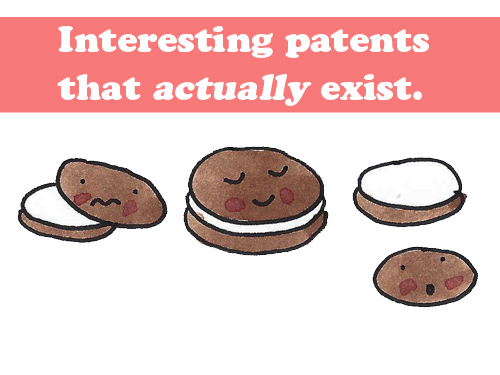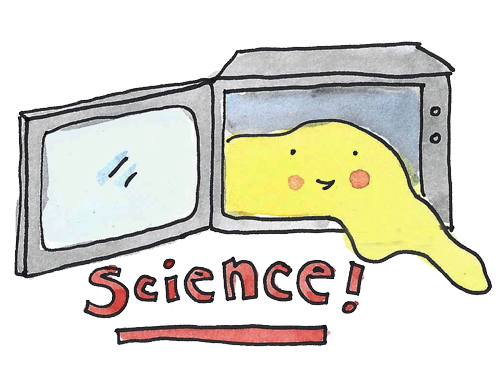Not so long ago, finding myself in an extended airport layover, I did what any normal person would do: I started looking up unusual patents pertaining to baked goods. Trust me, there are a ton. Imagining everything that goes into pursuing a patent for a method or invention absolutely boggles my mind--there's a lot more to it than simply having an idea and saying "OK, patent me!". Months--sometimes years--of work go into the process. That is to say--these people really wanted to patent their idea.
The thing that I wish I had more information about is documentation of how and when the patents might have been applied to products; sadly, this information is not immediately available. Please, let me know if you might have any thoughts!
But in the meantime, here are just a few patents that caught my eye:
US Patent 5,374,438 (1994): QUICK-SETTING SANDWICH BISCUIT CREAM FILLINGS.
Held by: Nabisco
What it is: quick-setting sandwich biscuit cream fillings that resist misalignment, smearing and decapping.
More info than you needed: Sandwich cookies and crackers occupy a significant place in the world biscuit market. Typically, two identical biscuits (the shells or basecakes) contain a layer of sweet or savory fat cream filling....
The fat component of sandwich cookie and cracker cream fillings affects not only the eating character of the product, but other important aspects of process and quality. The sandwich cream filling should be firm at ambient temperature to maintain product shape and not squeeze out on handling or when bitten, yet have organoleptic properties allowing rapid melting in the mouth to release ingredients giving maximum flavor sensation without greasiness. The sandwich cream filling should adhere to the biscuits so that the basecakes do not become misaligned or smeared, and the product does not fall apart (known as splitting or decapping) in production or after storage.
It would be desirable to have sandwich biscuit cream fillings that accomplish these goals without the use of bonding agents or specialized manufacturing equipment.
- - - - -
US Patent 5,532,017 (1996) MELT RESTRICTED MARSHMALLOWS
What it is: a marshmallow confection product having melt resistant properties.
More info than you needed: Typical marshmallow products cannot be used in high temperature processes, such as baking, due to their inability to retain identity and texture under elevated temperatures that are standard in baking conditions, i.e., 350.degree. F. for 20 minutes. Upon exposure to heat, marshmallow air cells expand and the gelatin destabilizes causing the air cells to collapse and reducing the marshmallow to a syrupy liquid state that dissolves into the bakery medium. This property has limited the use of marshmallows as a baking ingredient due to loss of product attributes which identify the marshmallow ingredient.
- - - - -
US Patent 5,860,358 (1998): CONE CAKE BAKING APPARATUS.
What it is: A cone cake baking apparatus comprising: a horizontal baking tin having a plurality of circular openings, a vertical first side wall, and a vertical second side wall; and the first and second side walls each having a securing portion.
More info than you needed: While it is well known in the prior art to utilize cup cake trays for baking cupcakes, the public domain does not contain an adequate apparatus for baking cone cakes. In particular, in order to cook a cone cake having a pointed bottom with available apparatus, it is necessary to fill the cone with cake material and place the cone cakes in a vertical position, lying down, on a cookie sheet. Moreover, while standard cupcake trays will more easily facilitate a flat bottom cone, baking such cones in cupcake trays often results in spillage or tipping of the cones during the baking process.
- - - - -
US Patent 3,649,304 (1972): REFRIGERATED SOLID BATTER .
What it is: A refrigerated solid batter for making flour based products, such as cakes, cookies, muffins, bread and the like, and the process for making same generally consisting of mixing gelatin or other stabilizing agent of similar characteristics with fluid and dry ingredients to which is added chemical leaveners, such as a basic and an acid leavener, mixing same in liquid state before solidification of the stabilizer, sealing the batter in a container and refrigerating the same at a temperature below the melting point of the stabilizer to solidify same for marketing same as a refrigerated product.
More info than you needed: Packaged dry mixes for making bread, pancakes, cakes, cookies and other like food products have become very popular by reason of the convenience afforded the housewife in preparation and cooking such products. These convenience products have all the ingredients therein necessary to the cooking or baking of the finished product with the exception of the fluid such as milk or water, and in many instances fresh eggs must be added thereto and the product stirred and mixed in suitable form for grilling or baking. In the case of rolls or biscuits the dough must be rolled out and cut before placing it in the pan and in the case of cake the batter must be beat for a predetermined period, either by hand or by mechanical mixer, thus requiring a considerable amount of time and effort and the cleaning up of kitchen utensils, such as mixing bowls, spoons, beaters, mixers, etc., after the preparation of the product, which results in considerable effort and inconvenience on the part of the housewife.
No satisfactory means has heretofore been provided for stabilizing premixed cake batter to give it commercial value. In the process and product hereinafter described premixed cake batter is solidified with a reversible stabilizing agent to achieve bacteriological, chemical and physical stability to provide a prepared, packaged, ready-to-cook batter which may be preserved for a prolonged period of time and when cooked provides a product of good texture and palatability.
- - - - -
US Patent 6,410,073: MICROWAVEABLE SPONGE CAKE, and US Patent 6,410,074 (2001): Method for making a microwaveable sponge cake
What it is: a mesophase-containing sponge cake which rises and forms a palatable, light sponge cake when prepared in a microwave oven, yielding a snack food-type products which can easily be prepared by the consumer.
More info than you needed: Sponge cakes are a desirable dessert products. Generally, oven-rising sponge cakes are limited to those for use in a conventional oven and are not as convenient as desired. Microwaved cereal products such as breads and cakes are generally not pleasing to the palate. Microwave heating is generally uneven and, therefore, promotes the rapid onset of staleness and toughness in such cereal products.
Microwaved sponge cakes and products are especially desirable as snack foods (e.g., after school snacks). Such sponge cake batters could be sold directly in, for example, cupcake cups and stored in the freezer until until prepared in a microwave oven. Such products would be attractive to the consumer and convenient to use. Indeed, such sponge cake products could be easily prepared by children.






